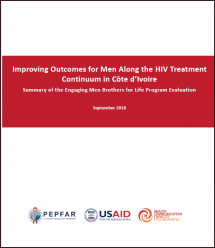Improving Outcomes for Men Along the HIV Treatment Continuum in Côte d’Ivoire – Summary of the Engaging Men Brothers for Life Program Evaluation
Brothers for Life (BFL) is a USAID-sponsored program designed to increase engagement in the HIV care continuum for men in Côte d’Ivoire. BFL Côte d’Ivoire is being implemented by the JHU Center for Communication Programs (CCP)–Côte d’Ivoire Office in partnership with local service delivery non-governmental organizations (NGOs).
The primary audience for BFL was men who engage in HIV risk behaviors, aged 25 years and above, married or unmarried, in both urban and peri-urban areas. The program aims to support men as they progress through the HIV treatment continuum, from HIV testing and entry-into-care, through antiretroviral therapy (ART) initiation and retention. The program is comprised of a series of five facilitated community dialogues with groups of men. Discussion guides cover topics such as family budgets, sexual and reproductive health, men as sex partners, men’s roles in families and society, and HIV/AIDS. BFL was implemented in three sites: Yopougon, Bouaké, and San Pédro.
The overall objective of the activity is to engage high-risk men more effectively in the treatment continuum, beginning with HIV prevention and testing, and continuing through treatment initiation and adherence outcomes. The process of moving from an initial HIV diagnosis to accepting one’s result, preparing for disclosure, finding familial or community support, initiating and maintaining treatment adherence, and ultimately obtaining viral suppression is a complex process and one that is not linear for many people. Given that identifying high-risk men and
encouraging them to test for HIV has been a challenge in Côte d’Ivoire, the 5-year global Health Communication Capacity Collaborative (HC3) project used the Brothers for Life© (BFL) platform (described above) to address this gap and other critical barriers identified through rigorous research.
Source: Johns Hopkins Center for Communication Programs
Date of Publication: January 21, 2020
SIMILIAR RESOURCES
Tools
Examples
- Guidance for the Prevention of Sexually Transmitted HIV Infections
- Treatment 2015
- Guide de Formation Conseil Dépistage du VIH au niveau Communautaire: manuel à l'intention du personnel non médical
- Guidelines for the Use of Antiretroviral Agents in HIV-1-Infected Adults and Adolescents
- Consolidated Guidelines on the Use of Antiretroviral Drugs for Treating and Preventing HIV Infection
- Toolkit for Transition of Care and Other Services for Adolescents Living with HIV
- Adolescents Living with HIV (ALHIV) Toolkit
- Antiretroviral Therapy for HIV Infection in Infants and Children: Recommendations for a Public Health Approach
- Joint WHO/ILO Guidelines on Post-Exposure Prophylaxis (PEP) to Prevent HIV Infection
- Optimizing Entry Into and Retention in HIV Care and ART Adherence for PLWHA
- Améliorer les résultats pour les hommes tout au long du continuum de traitement du VIH en Côte d'Ivoire -Résumé de l'évaluation du Programme Frères Pour la Vie
- Materiaux de Campagne Tester Traiter TOT - Materials from Test and Treat TOT Campaign, Côte d’Ivoire
- Campagne Tester Traiter TOT
- Les supports de communication" tester traiter tous"
- Programmes super go & super tata: Guide de mise en œuvre des activités communautaires

